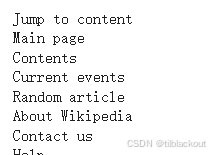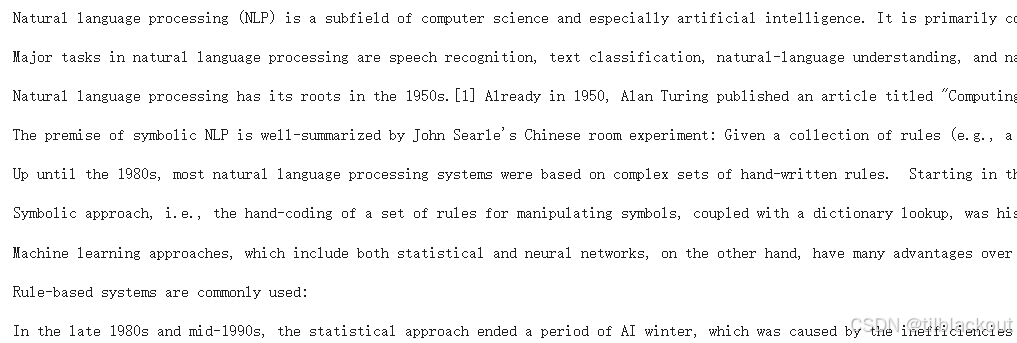在人工智能的众多分支中,自然语言处理(Natural Language Processing,NLP)是一项非常贴近我们日常生活的技术。无论是智能客服、语音助手,还是各类推荐系统,它们背后都少不了 NLP 的参与。NLP 的目标,是让计算机能够理解、分析甚至生成类似人类的语言。
然而,在真正开始做 NLP 项目之前,我们往往会面临一个非常现实的问题:如何获取干净、结构化的文本数据?这一步虽不起眼,却是整个自然语言处理流程中极其重要的基础。
所以这一篇文章,我们先来看一看现实中可以利用的各种数据来源,然后提取它们。
文章目录
1 数据收集
现实中常用的数据来源包括企业内部数据(如数据库、云存储)、公开数据(政府网站、百科),还可以通过爬虫提取网页中的数据。
1.1 从PDF中收集数据
我们可以使用 PyPDF2 库可以很方便地提取 PDF 文本信息。
- 该方法不支持扫描类 PDF(即图像格式)
安装并导入库:
!pip install PyPDF2
import PyPDF2
from PyPDF2 import PdfFileReader
提取文本内容:
pdf = open("file.pdf", "rb")
pdf_reader = PyPDF2.PdfFileReader(pdf)
print(pdf_reader.numPages)
page = pdf_reader.getPage(0)
print(page.extractText())
pdf.close()
1.2 从Word文档中收集数据
使用 docx 库可以读取 .docx 文件。首先安装并导入库:
!pip install docx
from docx import Document
提取文本内容:
doc = open("file.docx", "rb")
document = docx.Document(doc)
docu = ""
for para in document.paragraphs:
docu += para.text
print(docu)
1.3 从JSON中收集数据
使用 json 库可以解析 JSON 内容:
# import requests # 如果想访问网站中的json
import json
假设本地有一个quote.json文件:
{
"contents": {
"quotes": [
{
"quote": "Where there is ruin, there is hope for a treasure.",
"length": "50",
"author": "Rumi",
"tags": [
"failure",
"inspire",
"learning-from-failure"
],
"category": "inspire",
"date": "2018-09-29",
"title": "Inspiring Quote of the day",
"id": "dPKsui4sQnQqgMnXHLKtfweF"
}
]
}
}
读取 JSON 并提取内容:
import json
# 读取本地 JSON 文件
with open('quote.json', 'r', encoding='utf-8') as f:
res = json.load(f)
# 打印格式化后的内容
print(json.dumps(res, indent=4))
# 提取名言部分
q = res['contents']['quotes'][0]
print(q['quote'], '\n--', q['author'])
1.4 从 HTML 页面中收集数据
如果想要解析网页(HTML 页面)内容,可以使用 bs4(BeautifulSoup)库来解析与提取。
安装并导入库:
!pip install bs4
import urllib.request as urllib2
from bs4 import BeautifulSoup
接着我们获取网页 HTML 内容:
response = urllib2.urlopen('https://en.wikipedia.org/wiki/Natural_language_processing')
html_doc = response.read()
解析 HTML 页面:
soup = BeautifulSoup(html_doc, 'html.parser')
strhtm = soup.prettify()
print(strhtm[:1000])
输出:

提取指定标签内容:
print(soup.title)
print(soup.title.string)
# 提取 HTML 页面中第一个 <a> 标签和 <b> 标签中纯文本内容的语句
print(soup.a.string)
print(soup.b.string)
输出:

提取所有指定标签实例:
for x in soup.find_all('a'):
print(x.string)
输出:

提取页面中所有段落(p标签)文本:
for x in soup.find_all('p'):
print(x.text)
输出:

1.5 使用正则表达式解析文本
我们可以使用正则表达式解析文本数据,常用的是Python的re库。
常用标志位(flags)如下:
re.I:忽略大小写匹配re.L:本地化识别re.M:多行匹配re.S:匹配包括换行符的任意字符re.U:支持 Unicodere.X:使正则更具可读性
常用正则语法举例:
[ab]:匹配单个字符 a 或 b[^ab]:匹配除了 a 和 b 的字符[a-z]:匹配 a 到 z[^a-z]:匹配除 a 到 z 之外的字符[a-zA-Z]:匹配大小写字母.:匹配任意单个字符\s:匹配空白字符\S:匹配非空白字符\d:匹配数字\D:匹配非数字\w:匹配单词字符\W:匹配非单词字符(a|b):匹配 a 或 ba?:匹配 0 或 1 次a*:匹配 0 次或多次a+:匹配 1 次或多次a{3}:匹配恰好 3 次a{3,}:匹配 3 次及以上a{3,6}:匹配 3 到 6 次^:匹配字符串开头$:匹配字符串结尾\b:匹配单词边界\B:非单词边界
re.match() vs re.search()
re.match(): 从字符串的头开始匹配
re.search(): 查找整个字符串中的匹配
下面来看几个正则表达式的例子:
(1)分词(Tokenizing)
import re
re.split('\s+', 'I like this book.')
# 输出:['I', 'like', 'this', 'book.']
(2)提取 Email
doc = "For more details please mail us at: xyz@abc.com, pqr@mno.com"
addresses = re.findall(r'[\w\.-]+@[\w\.-]+', doc)
for address in addresses:
print(address)
# 输出:
# xyz@abc.com
# pqr@mno.com
(3)替换 Email
doc = "For more details please mail us at xyz@abc.com"
new_email_address = re.sub(r'([\w\.-]+)@([\w\.-]+)', r'pqr@mno.com', doc)
print(new_email_address)
# 输出:
# For more details please mail us at pqr@mno.com
(4)文本查找和替换
import re
text = """
*** START OF THIS PROJECT ***
This is a sample text document created for testing regex operations.
It includes numbers like 123, special symbols like % and $, and some repeated patterns.
We will do a search and replace operation using regular expressions.
End of the sample.
"""
# 使用 re.search 查找文本中特定标记的起始位置
start = re.search(r"\*\*\* START OF THIS PROJECT \*\*\*", text).end()
# 从 start 位置之后截取文本
content = text[start:]
# 使用 re.sub 进行清洗,只保留字母、数字和句号
def preprocess(sentence):
return re.sub('[^A-Za-z0-9.]+', ' ', sentence).lower()
# 处理文本
processed_content = preprocess(content)
# 输出结果
print("原始内容:\n", content)
print("\n处理后内容:\n", processed_content)
输出如下:

1.6 分析文本
# “the” 出现次数
len(re.findall(r'the', processed_book)) # 输出:302
# 替换 ' i ' 为 ' I '
processed_book = re.sub(r'\si\s', " I ", processed_book)
# 查找形如 abc--xyz 的字符串
re.findall(r'[a-zA-Z0-9]*--[a-zA-Z0-9]*', book)
1.7 字符串处理
常用字符串操作
s.find(t)
s.rfind(t)
s.index(t)
s.rindex(t)
s.join(text)
s.split(t)
s.splitlines()
s.lower()
s.upper()
s.title()
s.strip()
s.replace(t, u)
替换字符串:
String_v1 = "I am exploring NLP"
print(String_v1[0]) # 输出:I
print(String_v1[5:14]) # 输出:exploring
String_v2 = String_v1.replace("exploring", "learning")
print(String_v2) # 输出:I am learning NLP
拼接两个字符串:
s1 = "nlp"
s2 = "machine learning"
s3 = s1 + s2
print(s3) # 输出:nlpmachine learning
查找子串索引:
var = "I am learning NLP"
f = "learn"
print(var.find(f)) # 输出:5
1.8 网页抓取(Web Scraping)
抓取网页前请阅读网站的使用条款,确认是否允许抓取。从网页上大规模提取数据,并保存在本地或数据库,用于用户、产品等信息分析。
首先安装依赖:
!pip install bs4
!pip install requests
导入库:
import requests
from bs4 import BeautifulSoup
发起请求并解析网页内容:
url = 'https://example.com'
response = requests.get(url)
soup = BeautifulSoup(response.content, 'html.parser')
提取需要的数据:
for p in soup.find_all('p'):
print(p.text)
我们可以根据网页结构,通过标签名(如 div、span)、类名(class_="xxx")、ID(id="xxx")等定位内容进行提取。
2 总结
文本数据的提取是自然语言处理的第一步,也是非常关键的一步。只有掌握了从各种来源(如本地文件、网页等)高效获取数据的能力,后续的文本清洗、建模、分析工作才能顺利进行。


























 被折叠的 条评论
为什么被折叠?
被折叠的 条评论
为什么被折叠?










